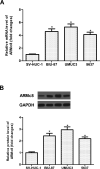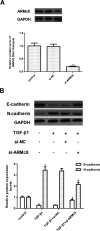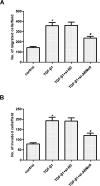Silencing of Armadillo Repeat-Containing Protein 8 (ARMc8) Inhibits TGF-β-Induced EMT in Bladder Carcinoma UMUC3 Cells
- PMID: 28081738
- PMCID: PMC7840676
- DOI: 10.3727/096504016X14719078133609
Silencing of Armadillo Repeat-Containing Protein 8 (ARMc8) Inhibits TGF-β-Induced EMT in Bladder Carcinoma UMUC3 Cells
Abstract
Armadillo repeat-containing protein 8 (ARMc8) is a key factor in regulating cell migration, proliferation, tissue maintenance, and tumorigenesis. However, its role in bladder cancer remains unknown. Thus, in this study we sought to investigate the effect of ARMc8 on the epithelial-to-mesenchymal transition (EMT) progress in bladder cancer cells induced by transforming growth factor-β1 (TGF-β1). Our results found that ARMc8 was highly expressed in bladder cancer cell lines. ARMc8 silencing inhibited the TGF-β1-induced migration and invasion and suppressed the EMT progress in bladder cancer cells. Furthermore, ARMc8 silencing inhibited the TGF-β1-induced expression of β-catenin, cyclin D1, and c-myc in bladder cancer cells. In conclusion, the present study demonstrates a novel function for ARMc8, which acts as a mediator for TGF-β1-induced cell migration/invasion through modulation of the Wnt/β-catenin signaling pathway in bladder cancer cells. This study suggests that ARMc8 may be a potential therapeutic target for the development of therapies for bladder cancer.
Conflict of interest statement
The authors declare no conflicts of interest.
Figures




Similar articles
-
MiR-455-3p inhibits gastric cancer progression by repressing Wnt/β-catenin signaling through binding to ARMC8.BMC Med Genomics. 2023 Jul 3;16(1):155. doi: 10.1186/s12920-023-01583-y. BMC Med Genomics. 2023. PMID: 37400847 Free PMC article.
-
Armadillo Repeat-Containing Protein 8 (ARMC8) Silencing Inhibits Proliferation and Invasion in Osteosarcoma Cells.Oncol Res. 2016;24(5):381-389. doi: 10.3727/096504016X14685034103392. Oncol Res. 2016. PMID: 27712595 Free PMC article.
-
Downregulation of ARMC8 promotes tumorigenesis through activating Wnt/β-catenin pathway and EMT in cutaneous squamous cell carcinomas.J Dermatol Sci. 2021 Jun;102(3):184-192. doi: 10.1016/j.jdermsci.2021.05.002. Epub 2021 May 10. J Dermatol Sci. 2021. PMID: 34016486
-
Role of microRNA/Epithelial-to-Mesenchymal Transition Axis in the Metastasis of Bladder Cancer.Biomolecules. 2020 Aug 7;10(8):1159. doi: 10.3390/biom10081159. Biomolecules. 2020. PMID: 32784711 Free PMC article. Review.
-
Malignancy and IFITM3: Friend or Foe?Front Oncol. 2020 Dec 8;10:593245. doi: 10.3389/fonc.2020.593245. eCollection 2020. Front Oncol. 2020. PMID: 33364194 Free PMC article. Review.
Cited by
-
The CTLH Complex in Cancer Cell Plasticity.J Oncol. 2019 Nov 30;2019:4216750. doi: 10.1155/2019/4216750. eCollection 2019. J Oncol. 2019. PMID: 31885576 Free PMC article. Review.
-
The micro RNA hsa-miR-377-3p inhibits tumor growth in malignant melanoma.RSC Adv. 2019 Jun 17;9(33):19057-19064. doi: 10.1039/c9ra02816a. eCollection 2019 Jun 14. RSC Adv. 2019. PMID: 35516861 Free PMC article.
-
The human GID complex engages two independent modules for substrate recruitment.EMBO Rep. 2021 Nov 4;22(11):e52981. doi: 10.15252/embr.202152981. Epub 2021 Oct 14. EMBO Rep. 2021. PMID: 34647674 Free PMC article.
-
MiR-455-3p inhibits gastric cancer progression by repressing Wnt/β-catenin signaling through binding to ARMC8.BMC Med Genomics. 2023 Jul 3;16(1):155. doi: 10.1186/s12920-023-01583-y. BMC Med Genomics. 2023. PMID: 37400847 Free PMC article.
-
Comprehensive analysis of the expression and prognostic value of ARMCs in pancreatic adenocarcinoma.BMC Cancer. 2025 Jan 7;25(1):28. doi: 10.1186/s12885-024-13365-5. BMC Cancer. 2025. PMID: 39773340 Free PMC article.
References
-
- Torre L. A.; Bray F.; Siegel R. L.; Ferlay J.; Lortet-Tieulent J.; Jemal A. Global cancer statistics, 2012. CA Cancer J. Clin. 65:87–108; 2015. - PubMed
-
- Kluth L. A.; Black P. C.; Bochner B. H.; Catto J.; Lerner S. P.; Stenzl A.; Sylvester R.; Vickers A. J.; Xylinas E.; Shariat S. F. Prognostic and prediction tools in bladder cancer: A comprehensive review of the literature. Eur. Urol. 68:238–253; 2015. - PubMed
-
- James N. D.; Hussain S. A.; Hall E.; Jenkins P.; Tremlett J.; Rawlings C.; Crundwell M.; Sizer B.; Sreenivasan T.; Hendron C. Radiotherapy with or without chemotherapy in muscle-invasive bladder cancer. N. Engl. J. Med. 366:1477–1488; 2012. - PubMed
MeSH terms
Substances
LinkOut - more resources
Full Text Sources
Other Literature Sources
Medical
Research Materials
